Homemade hot links sausage, the one that you can even enjoy cold, on its own, like fine salami. Heated up on a grill or a pan it's the bomb! The heat is at about medium-low level. It's very pleasant and will be palatable to most sausage eaters. If you've tried my Andouille sausage, the heat level is the same. If you like the real heat, you'd want to bump the amount of pepper up to suit your taste.
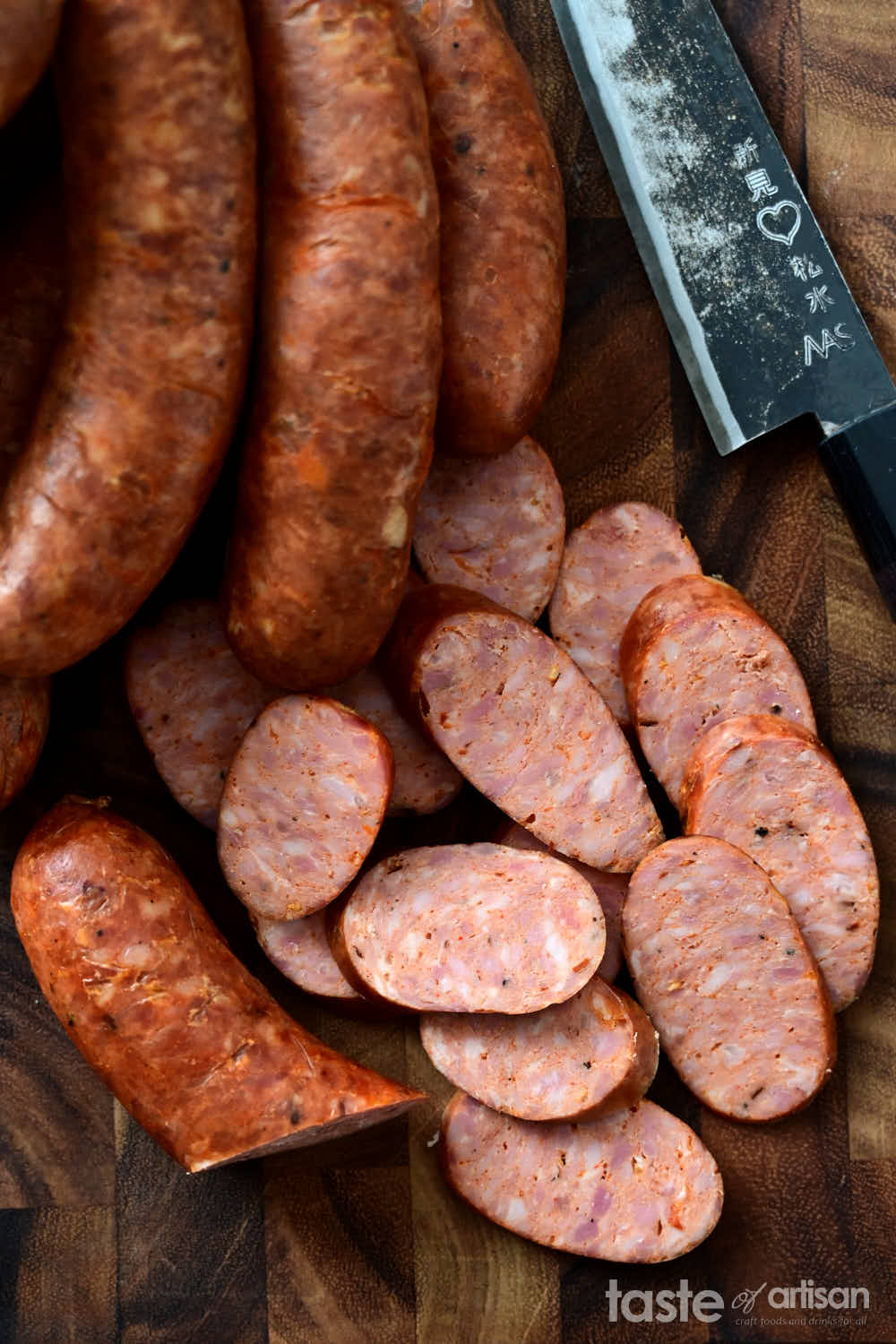
What is hot links sausage?
Hot links is a type of sausage commonly found in the Southern United States. Hot links sausage is a part of American barbecue, soul food, and Cajun and Louisiana Creole cuisines. Other parts of the US are also known for their hot links sausage such as Texas and Chicago, Illinois. Hot links are usually prepared using pork, beef, or a combination of both. This sausage is sometimes used as an ingredient in other dishes, such as jambalaya and gumbo.
I haven't been a fan of hot links until quite recently. The biggest reason is that what I'd been exposed to was generally very low-quality, mass-produced versions of this iconic sausage. That quickly changed once I made this sausage myself and realized that it can rival some of the best kielbasas. I shouldn't be surprised though, really. I mean, take a look at the pepperoni, summer sausage, salami, andouille, and more. The difference between homemade and mass-produced commercial sausage is striking. The only way you can eat store-bought hot links is by frying or grilling them and serving them on a bun with a load of condiments. Not this one. This sausage you can eat cold, on its own, and love every bite of it.
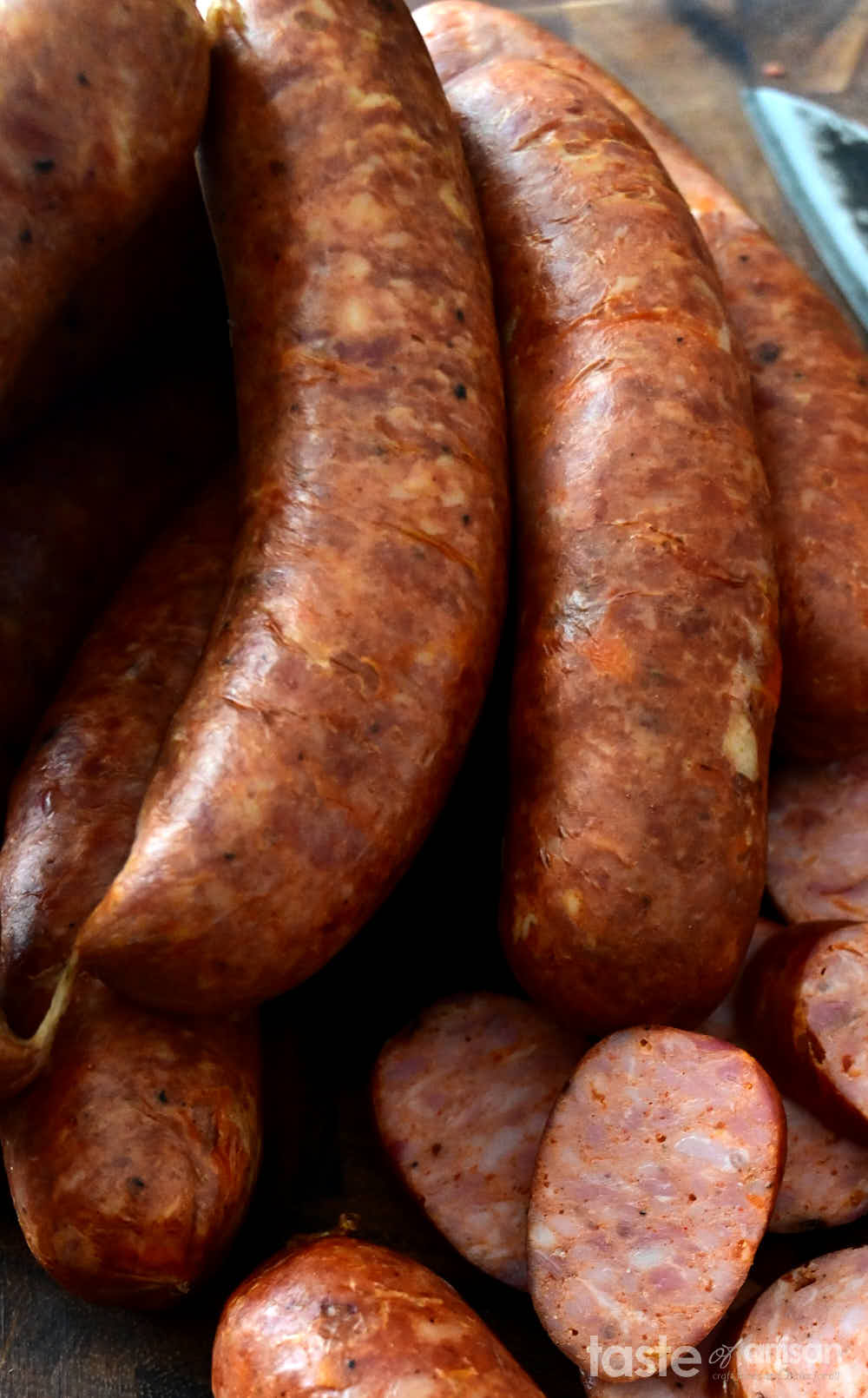
Hot links recipe
This recipe is a modified adaptation of Eldon Cutlip's hot link recipe from his Sausage And Jerky Handbook. Somehow other recipes that I tried and which used fennel, parsley, oregano, sage and other herbs just didn't tickle my tastebuds. Eldon Cutlip's recipe is dead simple and makes tasty sausage. It uses just garlic and onion powder, paprika and red pepper flakes for aromatics and flavor. I like simple flavors, they usually create the best taste.
My first attempt at this sausage was not bad but I saw room for improvement. The first thing I did was to replace beef fat with pork backfat. Sure, beef fat has a higher melting point but pork backfat or even pork belly are very good substitutions in that respect. In the taste and texture department, pork fat beats beef fat every time. This made quite a noticeable difference to the texture of the sausage.
Other changes included modifying some proportions and adding black pepper, replacing some of the red pepper flakes with cayenne pepper and freshly ground chipotle chile pepper. Oh my, that really improved the aromatics. Oh, and I used brown sugar in place of corn syrup solids which I don't normally have or use in my sausage recipes. I dropped the amount of sugar too as I felt that the original recipe was pushing a little too much sweetness for my taste.
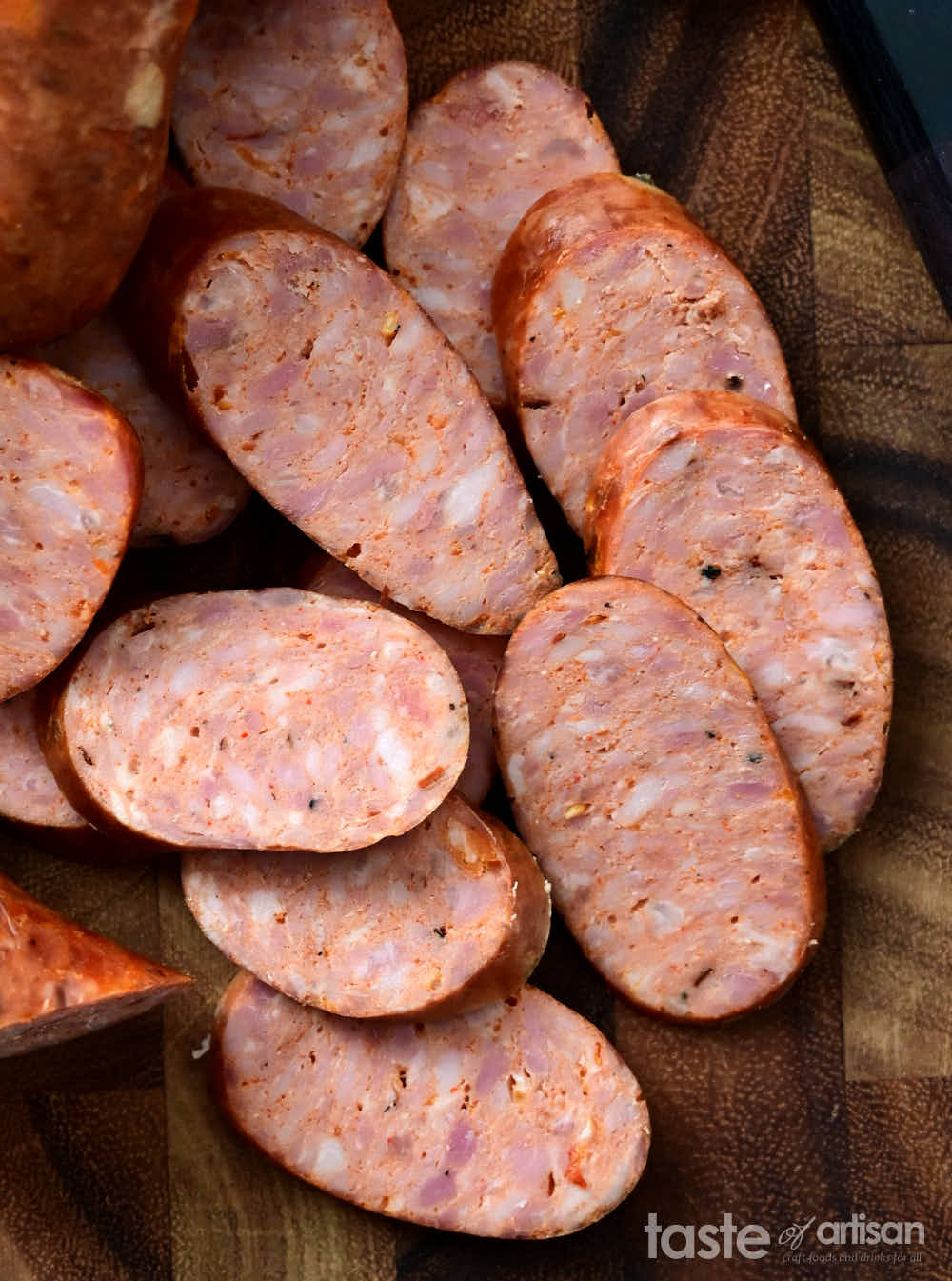
Required equipment
If you are new to sausage-making, you will need to make sure that you have a good meat grinder and a sausage stuffer. I have 20lb and 5lb LEM sausage stuffers. A 5lb stuffer is great for smaller batches and a 20lb motorized stuffer is great for large batches of sausage. My LEM #8 meat grinder is light enough to carry around and does the job quickly even with large batches of meat.
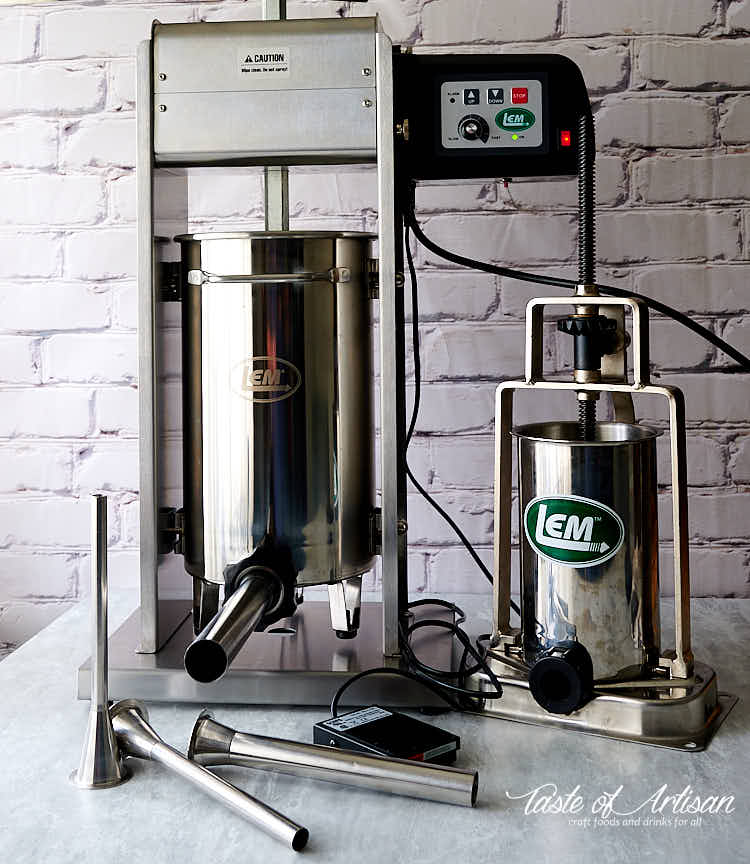
A meat mixer is nice to have, I still don't own one after a decade of making sausage on a regular basis. Though, I am very strongly considering getting one in the near future.
Finally, you will need a smoker that is capable of smoking at 140F. An electric smoker would be perfect for this job. Most propane, charcoal and pellet smokers can't get that low. I use to use a propane smoker modded with a needle valve and it did the job until I built a smokehouse specifically for making sausage. If you don't have any of those, cook on a regular smoker or grill at the lowest temp you can obtain, I've done that on my Biog Green Egg and the sausage turned out really good (see my Summer Sausage post for details) . As a last resort, just bake the sausage in the oven. It will still taste great after you warm it up on a grill or a pan.
Making hot links
The process is very simple and is very similar to that of making any other sausage. I cut the meat into 2" pieces, rub with salt and cure #1 and cure for at least 12 hours and up to 24-48 hours in the fridge. After that, I grind the meat through a 1/4" (6mm) plate. The more common size for this sausage would be 3/16" (4.5mm) or even 1/8" (3mm) but I feel like a coarser grind gives this sausage better texture. I personally like it more this way. I grind pre-frozen fat through the same plate size. After grinding, I mix the meat with spices and water and stuff it into 28-32mm hog casings.
I think that the best way to make hot links is to smoke them. Low and slow, at about 130F - 140F, would be ideal. Smoke for a few hours over whichever fairly strong wood you like such as hickory, pecan, or cherry. If your smoker doesn't go down this low, smoke at 200F or so, most smokers can do that. Finish by raising the smoker temperature to 175F to 185F until the internal temperature of the sausage reaches 154F - 158F. Another way to finish is to poach or sous vide this sausage at 161F - 167F for 20-30 minutes. Or throw them in the oven and bake at 175F for40-60 min or so, until the desired internal temp is achieved.
If you don't have access to a smoker, you can simply bake or grill your hot links. If you plan on cooking them quickly - under 3 hours total cooking time - you don't need to use Cure #1, simply substitute it with salt. Cure #1 is only needed for safety when cooking sausage over extended periods of time while the meat is in the danger zone - between 40F and 140F. Though, keep in mind that cure #1 gives the sausage a nice pink color, improves the flavor and extends its shelf life.
How to cook hot links?
Fully cooked hot links sausage, such as this one, does not need additional cooking. Simply slice, make a sandwich and enjoy. If you like your sausage warmed up, there are several ways to do that. Air frying, grilling and pan-frying or broiling are my top choices to heat up hot links. Cook until the internal temperature in the center of the sausage reaches 160F. Do not overcook!
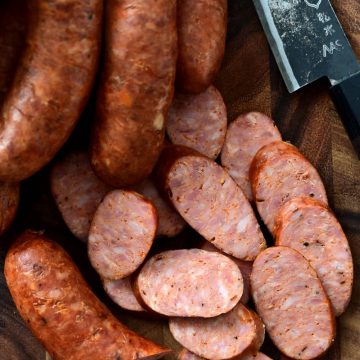
Hot Links Sausage
Ingredients
- 4 1/2 lbs pork butt about 2,050g
- 1/2 lb pork backfat or fatty pork belly; about 230g
- 5 1/2 tsp kosher salt or sea salt; heaping tsp; about 33g total
- 1 tsp Cure #1 level tsp; 5g
- 1 1/2 tsp granulated garlic about 4.5g
- 1 1/2 tsp granulated onion about 7g
- 1 tsp black pepper coarsely ground; about 4g
- 1 Tbsp dark brown sugar about 16g
- 1 1/2 Tbsp sweet paprika about 14g
- 2 tsp red pepper flakes about 4.5g
- 1 1/2 tsp cayenne pepper about 4.5g
- 1 1/4 tsp ground chipotle pepper about 4.5g
- 1/2 cup dry milk about 56g
- 1/2 cup ice water plus more if needed, up to a cup
- 28-32 mm hog casings
Instructions
- Cut the meat and the fat into 2" pieces, rub with a mix of salt and cure #1, and refrigerate for at least 12 hours and up to 24-48 hours.
- Grind the pork and the pork belly/back fat (partially frozen for 20 min in a freezer) through a medium size plate - 1/4" (6mm).
- Add the ice water, all of the spices and mix well, until the meat is sticky.
- Stuff into 28-32mm hog casings, twist into about 6" links and hang to dry at room temperature for 2-3 hours.
- Preheat your smoker to 130F - 140F.
- Hang sausages in the smoker and dry for 30-60 minutes, until the skin is dry to touch without smoke. Then apply smoke for 3-4 hours until the desired color is achieved.
- Slowly raise the temperature in the smoker to 170F-175F until the internal temperature has reached 154F - 158F. You may have to increase the smoker temperature to 185F-195F to achieve that.
- Alternatively, poach the sausages in 167F water for 25 - 30 minutes or until the internal temperature is at least 154F. Poaching is a much quicker and more effective method. You can also bake the sausage in the oven at 175F for about 40-60 minutes to get the internal temperature to 154F.
- Cool the sausage down and store it in a refrigerator or a freezer. Cooling can be achieved by placing sausage in an ice bath to cool it down quickly. It with result in a fuller, more plump product. Similarly, you can place the sausage flat on a cool surface, like a granite countertop.


David Palmer says
I am from Queensland Australia. Like this recipe and will give it ago.
Victor @ Taste of Artisan says
Enjoy!
wayne Tomaszewski says
These are fantastic as is. Flavor, spice and heat is spot on. Thinking about trying some in smaller casings, to make a snack stick out of them. First thing I thought with my first bite, and then seen you did it too in comments. The older I get, the more spicy I like my food. LOL. Be making another 10lb batch here shortly, along with a 10lb batch of your Anndouille. If I don't make at least a 10lb batch of things, there's none left for me once the kids come by. Thanks for the great recipes
Victor @ Taste of Artisan says
Wayne, glad you liked my recipe. Spicy and in big batches, that sounds so familiar. 😉 Same here. And it's not just me who likes spicy anymore; it's the whole family. I recently made 3 types of sticks - Andouille, kabanos, and honey garlic, which is our favorite fresh sausage type. Guess which one disappeared first. Andouille! Some time ago, I made my Hungarian as sticks, and that one was a hit too, but I think Andouille is the reining queen right now. I even got lazy and used 21mm collagen casings and it was still excellent. I cut the meat up into smaller pieces though, about 1/2" - 3/4". Another thing my family started to like is when I dry them for 7-10 days in the garage or cold room. It wastes much, much better when it dries a little. My garage sits at about 42-46F and 50-60% RH all winter and well into spring, so perfect for drying smoked sausage. The cold room is about 50F, so works too. You want to keep the temp upder 55F. If you can find a cool place like that, I highly recommend it. If not, keep the sausage open in the fridge, don't stack it too much, it will dry out pretty quickly too. Enjoy!
wayne says
My brother and me have been making our own sausages for a while now, but have always used store bought seasonings, from B&P, LEM, etc. You opened up a whole new game for me here. Thanks. I'm going to be making these three here, the Andouille, Kabanos, and honey garlic into sticks next. Couple of questions if you don't mind. On the Kabanos, was the caraway ground or whole seed? With the honey garlic, did you cook and smoke them the way you did in the recipe, or lower and smoke for a while and increase the temp as you went? Last one for now for future reference, I have a older couple who live down the street who don't eat pork, and when we make our summer sausage, I always make some out of beef for them. I seen that you said the Kabanos can be made with beef, as well as your beef sticks, but was wondering if you tried any other of your recipes with beef, just out of curiosity? I'm pretty sure they would all work, but wanted to see if you could recommend some over the others. Thanks again.
Victor @ Taste of Artisan says
Hi Wayne, happy to hear it. I started off making sausage using pre-made seasonings too, but it was short-lived for me as I realized that those seasonings weren't 'my thing' and needed adjustments to suit my taste. Besides, most of those seasonings are nothing more than common seasonings you can find in your pantry and some unnecessary preservatives/flavor enhancers. But I digress. The caraway seeds are ground. Whenever I can, I use fresh whole seeds that I grind in a mortar or my cheapo blade coffee grinder right before mixing them in. The blade grinder leaves a lot of large pieces so I sift them out. I think a mortar is perfect for smaller batches and something like a blade grinder is better for large batches. The honey garlic in the recipe I posted is cooked at high heat. If I smoked it like traditional Polish sausage, I do it the same way as I do Kabanos.
As far as beef sausage goes, any recipe will work. Sausage is all about good quality meat and proportions. Seasonings are less important in my view. I make salami with nothing more than salt, pepper and a little garlic infused wine. That's how they make it in Italy. I use local pasture raised hog meat. That salami will knock most people's socks off. Many of my guests who try it are surprised at the flavor that comes from just those three basic seasonings. Same with smoked sausage. You can make sausage with just salt and pepper and it will be the most amazing sausage. The trick is to use good meat, a proper ratio of fat to meat, mixing well while keeping the meat cold to prevent fat separation, etc. I don't particularly like beef fat but it works. Using pork fat with beef would be ideal but if people don't eat pork you can't do that. Check out my sujuk recipe. It's dry cured but you can use the seasonings from it, I love that sausage. It's delicious but I've never tried to make it as smoked sausage. I am sure it will be good. I'd also recommend trying my smoked chicken sausage, especially for those who don't eat pork. I love that one too. Good luck!
wayne says
Forgot to rate this, but if it taste half as good as the smell, then I'll know it's a 5 star recipe that I'll make over and over.
Victor @ Taste of Artisan says
Good to hear it. It took me a few iterations to get this recipe right, and I am very happy with the results now. I hope you enjoy it as much as I do.
wayne tomaszewski says
Getting ready to put these on here in a little bit, trying out some Spanish Chorizo in the smoker right now. These look and smell great already. Was curious on why the dry milk and not Butcher and Packers special meat binder? New at this, and was wondering if the dry milk gives it a "flavor" or what? By the way, these looked so good, I made a double batch for myself. LOL. Thanks for your input.
Victor @ Taste of Artisan says
Hi Wayne, the more I make sausages (and other artisanal goodies), the more I lean towards more traditional, natural, and easier-to-source ingredients. I think powdered milk is just as good as B&P special meat binder, though I've never tried B&P's binder. Another example is the Sausage Maker's Fermento. I used to it in simpler sausage when I didn't want to bother with fermentation. However, I switched to powdered buttermilk, and the results were identical. I've read the Fermento actually is nothing but dehydrated buttermilk. Makes sense to me. I make my own kefir at home, same buttermilk only more flavor and bacterial strains, my plan is to dehydrate some to use in sausages.
Brett says
My first attempt at making sausage and it was a huge success. My family now thinks I am a pro sausage maker. Thank you for the recipe and detailed instructions.
Victor @ Taste of Artisan says
You are very welcome. Enjoy!
John says
Can I use Morton’s Tender Quick instead of the Prague #1? If so how much should I use?
Thank you.
Victor @ Taste of Artisan says
John, I've never used it so I can't advise.
Irvin McAllister says
This is the best hot link recipe I have used. I didn't get perfection, but my meat was not dry nor grainy. I added dry tomatoes and extra garlic!
Victor @ Taste of Artisan says
Glad to hear it. Enjoy!
Ken Vicknair says
Another fantastic recipe! Taste like my hometown Louisiana sausage!
Victor @ Taste of Artisan says
Glad to hear it. Enjoy!
Victor @ Taste of Artisan says
Recently, I've made this sausage in sheep casings and it was even better... I am becoming a huge fan of thin sausages and make most of my favorite sausages that way. Thin sausages are also very easy to finish in the smokehouse so I don't have to poach or oven-bake them.
John Karas says
thank you
Victor @ Taste of Artisan says
You are very welcome.
John Karas says
On your hot links do you use lean pork then add the pork fat? Or is there some fat in the pork butt then add the pork fat?
Victor @ Taste of Artisan says
Regular pork butt, so some fat already plus back fat on top. I tried with lean pork and back fat but didn't like it as much.